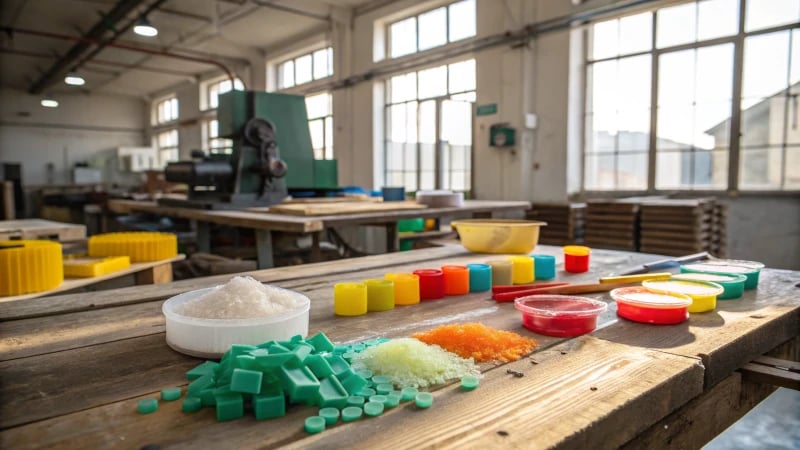
Ever wondered how we can make injection molding more eco-friendly? Enter biopolymers!
Biopolymers enhance injection molding sustainability by offering biodegradable, renewable alternatives to conventional plastics, reducing carbon footprint, and aligning with eco-friendly standards, ideal for environmentally-conscious manufacturers.
My journey into sustainable manufacturing was sparked by a personal quest for solutions that align with eco-friendly practices. I still remember the first time I stumbled upon biopolymers. It was like finding a hidden gem amidst the vast array of materials available for injection molding. These fascinating substances not only promise to reduce our carbon footprint but also come from renewable sources, which felt like a breath of fresh air.
The challenge, however, lies in seamlessly integrating these biopolymers into existing processes. It’s not just about swapping one material for another; it involves a deeper understanding of their properties, potential benefits, and the hurdles we might face along the way. In this exploration, I’ve found that while biopolymers are an exciting frontier, they require thoughtful consideration and adaptation to truly revolutionize the way we manufacture products sustainably.
Biopolymers reduce carbon footprint in injection molding.True
Biopolymers are derived from natural sources, reducing reliance on fossil fuels.
All biopolymers are biodegradable and eco-friendly.False
Not all biopolymers are biodegradable; some have similar durability to plastics.
- 1. What Are Biopolymers and How Are They Made?
- 2. How Do Biopolymers Compare to Traditional Plastics?
- 3. What Are the Environmental Benefits of Using Biopolymers?
- 4. Can Biopolymers Meet the Performance Standards of Injection Molding?
- 5. What Are the Challenges in Integrating Biopolymers into Existing Systems?
- 6. How are industries shifting towards biopolymer-based molding solutions?
- 7. Conclusion
What Are Biopolymers and How Are They Made?
Ever wondered if there’s a way to keep our planet green while crafting everyday essentials? Enter biopolymers—a game changer in sustainable materials.
Biopolymers are natural polymers from living organisms, mainly plants, created through fermentation and polymerization of monomers to form larger molecules.

Understanding Biopolymers
I remember the first time I heard about biopolymers; it was like finding a hidden key to unlock sustainable living. These are long-chain molecules made up of repeating units called monomers, but unlike their synthetic cousins, biopolymers1 come from renewable resources like plants, bacteria, and algae. They’re nature’s answer to our sustainability questions because they naturally decompose, which makes them perfect for those of us aiming to reduce our carbon footprint.
How Are Biopolymers Made?
The journey of creating biopolymers is fascinating. It’s like a craft that combines the magic of nature with the precision of science. There are several methods involved, but fermentation and polymerization are the rock stars of the show.
Fermentation Process:
Imagine selecting the best sugars or starches from corn, sugarcane, or beet as your starting point. This is where it all begins:
- Raw Material Selection: Picking these natural ingredients feels a bit like choosing the right tools for a project.
- Microbial Action: Then, under controlled conditions, microorganisms work their magic, digesting these raw materials.
- Product Extraction: Finally, it’s like unveiling the masterpiece as the biopolymer is extracted, purified, and processed into usable forms.
Polymerization Techniques:
Once, when I was deep into a project, I realized how crucial it is to have the right technique for every task:
- Ring-Opening Polymerization: This method cleverly converts cyclic monomers into linear polymers.
- Condensation Polymerization: It’s a bit like baking, where you might lose a few crumbs here and there as small molecules depart during polymer chain formation.
Applications and Advantages
Every time I see a product that uses biopolymers, I feel a sense of hope. They’re making waves in packaging, agriculture, medicine, and beyond. Their biodegradability is a huge win for the environment. For instance, biodegradable packaging2 offers a solution to plastic pollution in our oceans and landfills.
| Application | Benefit |
|---|---|
| Packaging | Reduces waste and enhances sustainability |
| Agriculture | Promotes soil health when used as mulch |
| Medical Implants | Biocompatibility minimizes rejection risks |
Challenges in Biopolymer Production
Of course, not all that glitters is gold. Despite their numerous benefits, biopolymers face hurdles in production. Economically scaling up production while ensuring quality is a tightrope walk. They also have to stand shoulder to shoulder with the established petrochemical industry in terms of cost and performance.
Future Prospects
But I’m optimistic about the future. Research is buzzing with efforts to improve production efficiency3 and develop new types of biopolymers with even better properties. As technology keeps advancing, I believe biopolymers will be pivotal in steering us towards sustainable development goals.
Biopolymers are always synthetic polymers.False
Biopolymers are derived from natural, renewable resources, not synthetic.
Fermentation is a method used to produce biopolymers.True
Microorganisms convert raw materials into biopolymers through fermentation.
How Do Biopolymers Compare to Traditional Plastics?
Have you ever wondered what sets biopolymers apart from traditional plastics? As we push for greener solutions, this question is more relevant than ever, especially for those of us in product design.
Biopolymers, derived from renewable resources, are biodegradable, unlike fossil fuel-based traditional plastics. This difference affects their strength, cost, and environmental footprint, influencing their application in various industries.

Origins and Composition
I remember the first time I realized the impact of our material choices in design. It was during a project where we had to rethink our approach due to environmental concerns. Biopolymers come from renewable sources4 like starch and cellulose—think of them as nature’s own gift that we can shape into something useful. Traditional plastics, on the other hand, are products of fossil fuels like petroleum.
| Material Type | Source | Example |
|---|---|---|
| Biopolymers | Renewable | Polylactic acid (PLA) |
| Traditional Plastics | Fossil Fuels | Polyethylene (PE) |
Environmental Impact
The first time I saw an infographic of plastic’s lifespan was eye-opening. Biopolymers are inherently biodegradable5, unlike conventional plastics that stick around for centuries. Picture this: while traditional plastics might outlive us all, many biopolymers will break down naturally, reducing the burden on landfills and oceans.
Performance Characteristics
Let’s talk shop—biopolymers bring a unique set of characteristics to the table. For example, PLA is strong and rigid but has its limits with high temperatures. I once faced a challenge when a prototype melted during testing because of this very limitation. Yet, advancements in material science are enhancing their capabilities every day.
Economic Considerations
If you’ve ever had to justify budget decisions, you know that cost is always a consideration. Biopolymers tend to be pricier than traditional plastics due to their smaller production scales and complex sourcing. However, as demand grows and innovations flourish, I believe we’ll see those costs come down, making them more accessible.
Applications and Innovations
From packaging to medical devices, biopolymers are making their mark. I remember being impressed by bio-based films6 used in food packaging—they’re a smart way to cut waste without compromising quality.
| Application | Biopolymer Example |
|---|---|
| Packaging | Bio-based films |
| Agriculture | Biodegradable mulch films |
| Medical Devices | Biodegradable sutures |
Future Prospects
As environmental awareness rises, so does the potential for biopolymers. With ongoing research focused on improving durability and reducing costs, it’s only a matter of time before they become mainstream in industries like ours. I’m hopeful for a future where our designs not only meet functional needs but also respect our planet.
Biopolymers are derived from fossil fuels.False
Biopolymers come from renewable resources like plants, not fossil fuels.
Traditional plastics are non-biodegradable.True
Traditional plastics persist in the environment for centuries without degrading.
What Are the Environmental Benefits of Using Biopolymers?
Imagine a world where the plastic in your gadgets is not only efficient but also kind to our planet.
Biopolymers reduce greenhouse gas emissions, decrease fossil fuel usage, and enhance biodegradability, aiding in plastic pollution reduction and promoting a circular economy aligned with sustainable development goals.

How Do Biopolymers Reduce Greenhouse Gas Emissions?
Biopolymers are a game-changer because they’re made from renewable resources like plants. These plants absorb carbon dioxide as they grow, which means they help reduce overall greenhouse gas emissions7. Plus, making biopolymers like PLA (polylactic acid) generally uses less energy than producing traditional plastics, which also helps cut emissions.
I remember the first time I stumbled upon this revelation—it was like finding a gold nugget in my backyard. As someone who grew up with a deep appreciation for nature, knowing that the materials I could choose for design could actively improve our environment was invigorating.
Decreasing Reliance on Fossil Fuels
The thing about traditional plastics is that they’re mostly made from petroleum, which uses up a lot of non-renewable resources. Biopolymers, on the other hand, come from things like agricultural products or waste, which means they lean on renewable sources. This shift is key to reducing our reliance on fossil fuels and boosting energy security and sustainability.
| Biopolymer Type | Renewable Source |
|---|---|
| PLA | Corn starch |
| PHB | Bacteria fermentation |
| PHA | Vegetable oils |
Enhanced Biodegradability and Mitigation of Plastic Pollution
One of the biggest wins for biopolymers is that they break down naturally over time. Unlike regular plastics that stick around for what feels like forever, biopolymers decompose into natural substances when they’re in composting facilities or soil. This helps tackle plastic pollution8, which is a huge environmental headache.
Promoting a Circular Economy
Biopolymers are basically the poster child for a circular economy. They can be recycled or composted, which means they go back into the earth as valuable nutrients instead of piling up as waste. This is way different from the linear economy of traditional plastics that usually end up in landfills or incinerators.
By using biopolymers in designs, product designers9 like me can really push for a sustainable future. It means aligning products with what eco-conscious consumers want and need. Digging deeper into how we can use these materials opens up room for innovation and a smaller ecological footprint.
These perks highlight just how crucial biopolymers can be in building more sustainable production systems and tackling major environmental challenges around the globe. It’s about creating a legacy that respects the planet while still delivering cutting-edge products.
Biopolymers reduce greenhouse gas emissions.True
Biopolymers absorb CO2 during growth and need less energy for production.
Traditional plastics are more biodegradable than biopolymers.False
Biopolymers decompose naturally, unlike traditional plastics.
Can Biopolymers Meet the Performance Standards of Injection Molding?
Biopolymers, with their promise of being eco-friendly, are making waves in the world of plastics. But as I delve deeper, I can’t help but wonder: can they truly stand up to the rigorous demands of injection molding like their synthetic counterparts? Let’s find out together.
Biopolymers can meet certain injection molding standards but may lack in heat resistance and durability, with their suitability varying based on specific application needs.

Understanding Biopolymers in Injection Molding
I remember the first time I encountered biopolymers. They seemed like the perfect solution for our increasingly eco-conscious world. Derived from renewable resources, these materials promise a smaller environmental footprint compared to traditional plastics. However, meeting the demanding performance standards10 of injection molding remains a significant hurdle.
Key Performance Metrics
As someone who’s spent countless hours tweaking designs to perfection, I’ve learned that evaluating biopolymers involves considering several key metrics:
| Performance Metric | Biopolymers | Traditional Plastics |
|---|---|---|
| Heat Resistance | Moderate | High |
| Durability | Varies | Excellent |
| Flexibility | Good | Excellent |
| Cost Efficiency | Improving | Established |
Application-Specific Considerations
The application dictates success more than anything else. I once worked on a project for consumer electronics, where high precision and heat resistance were non-negotiable. It was clear biopolymers might not be ready to replace conventional plastics there. But in packaging, their flexibility and biodegradability11 make them strong contenders.
Innovations and Future Prospects
The gap is closing, though. I recently read about biopolymer composites—where natural meets synthetic—that show promise in enhancing properties like strength and thermal stability12. Such innovations are exciting because they suggest a future where performance isn’t sacrificed for sustainability.
Real-World Examples
- Automotive Parts: I’ve seen companies experimenting with biopolymer components that not only meet safety standards but also offer eco-friendly benefits.
- Medical Devices: Development of biodegradable polymers for medical use is underway, showcasing their potential in demanding environments.
These real-world applications are paving the way for mold designers like myself to make informed decisions when considering sustainable materials for large-scale production13. As I continue to explore these options, I’m hopeful about what the future holds for biopolymers in injection molding.
Biopolymers outperform traditional plastics in heat resistance.False
Biopolymers have moderate heat resistance compared to high in traditional plastics.
Biopolymers are more cost-efficient than traditional plastics.False
Cost efficiency of biopolymers is improving but not yet surpassing established plastics.
What Are the Challenges in Integrating Biopolymers into Existing Systems?
Navigating the world of biopolymers is like embarking on a new adventure—exciting yet fraught with obstacles.
Integrating biopolymers into existing systems faces challenges like compatibility, cost, scalability, and performance, necessitating innovative approaches and a thorough understanding of both biopolymer properties and system requirements.

Material Compatibility Issues
I remember the first time I tried to integrate a biopolymer into a product design. It felt like trying to fit a square peg into a round hole. Biopolymers have unique molecular structures that don’t always play nice with systems crafted for conventional plastics14. To make them work, we often have to tweak our processes and equipment, and believe me, it’s not cheap!
Cost Constraints
Biopolymers remind me of that high-end gadget I’ve been eyeing—fantastic, but with a price tag that makes you think twice. They are still pricier than their petrochemical counterparts, which can make large-scale adoption a tough sell. In my experience, exploring bulk purchasing or seeking subsidies might bridge the gap. Evaluating their cost-effectiveness15 becomes essential as we weigh our options.
Scalability Concerns
Producing enough biopolymers to meet industrial demands? That’s like trying to keep up with the latest tech trends—it requires constant adaptation. Retrofitting facilities demands financial investment16 and patience. Ensuring consistent quality in large batches is no small feat either.
| Challenge | Description |
|---|---|
| Material Compatibility | Adjusting existing systems to accommodate different molecular structures. |
| Cost Constraints | Bridging the price gap between biopolymers and traditional polymers. |
| Scalability Concerns | Scaling production while maintaining quality and controlling costs. |
Performance Limitations
I once compared a biopolymer prototype’s strength to my trusty old toolbox—reliable but not quite as robust as modern materials. Biopolymers sometimes fall short in mechanical strength or thermal stability compared to traditional polymers. Research, including tweaking properties with additives or composites17, is our best bet for improvement. Balancing biodegradability with performance remains key.
By tackling these challenges head-on, we can pave the way for smoother integration of biopolymers into existing systems, ushering in an era of sustainable innovation.
Biopolymers are cheaper than traditional polymers.False
Biopolymers are currently more expensive than petrochemical-based polymers.
Scalability is a major challenge for biopolymer production.True
Producing biopolymers at scale requires significant investment and time.
How are industries shifting towards biopolymer-based molding solutions?
Imagine a world where our everyday plastics are not only functional but also environmentally friendly. This dream is becoming a reality as industries pivot towards biopolymer-based molding.
Industries are transitioning to biopolymer-based molding by investing in research, updating equipment, and adopting new design standards to boost sustainability without compromising product quality or performance.

Innovations and Research Investments
When I first heard about the shift to biopolymers, I was curious about how companies would match their performance with traditional plastics. It’s fascinating to see industries pouring resources into research, collaborating with academic institutions18, and pushing the boundaries of what’s possible. It’s almost like a new frontier in material science! For instance, I came across BioMold Inc., which has invested $5 million into developing heat-resistant biopolymers. GreenPolyTech and EcoPlastics are also making strides in flexibility and biodegradability, respectively.
| Company | Investment ($) | Focus Area |
|---|---|---|
| BioMold Inc. | 5 million | Heat resistance |
| GreenPolyTech | 3 million | Flexibility |
| EcoPlastics | 2 million | Biodegradability |
Equipment Modifications
My journey in the mold industry taught me that machinery adaptation is key when introducing new materials. Just like how I once had to tweak our factory’s processes for a new material line-up, manufacturers are now modifying machinery to handle biopolymers. Adjusting processing temperatures and cooling times ensures that these eco-friendly materials can be seamlessly integrated into existing systems. The machinery industry19 is stepping up to the challenge, designing equipment that harmonizes with a variety of biopolymers.
New Design Standards
I remember the first time I had to redesign a mold—it was both challenging and exhilarating. Now, designers are facing similar challenges but with biopolymers. New standards focus on the unique characteristics of these materials. Even CAD software is evolving, offering modules specifically for biopolymer design properties. Designers like Jacky are now equipped to optimize from the outset, creating products that meet modern sustainability standards without sacrificing performance.
Challenges and Opportunities
Every new venture comes with its hurdles. Biopolymers are no different—they bring challenges like cost variability and performance issues. However, I’ve always believed that where there’s a challenge, there’s an opportunity. In sectors like food packaging20, the biodegradability of biopolymers is a game-changer. Companies aligning with sustainability goals are not only enhancing their brand reputation but also responding to a growing consumer demand for green products. It’s like a wave of change that we can ride to a more sustainable future.
Biopolymers require modified manufacturing equipment.True
Existing machinery often needs adjustments for biopolymer processing.
All companies invest equally in biopolymer R&D.False
Investment varies; BioMold Inc. invests more than EcoPlastics.
Conclusion
Biopolymers enhance injection molding sustainability by offering biodegradable, renewable alternatives to plastics, reducing carbon footprints while facing challenges in integration and performance compared to traditional materials.
-
Explore real-world examples of biopolymers and their diverse applications to understand their practicality and significance. ↩
-
Discover how biodegradable packaging contributes to environmental conservation and why it’s becoming a preferred choice for eco-conscious businesses. ↩
-
Learn about the latest research efforts aimed at enhancing the efficiency of biopolymer production processes for broader application. ↩
-
Explore diverse renewable sources for biopolymers, enhancing understanding of sustainable material origins. ↩
-
Learn how quickly biopolymers decompose relative to conventional plastics, highlighting environmental benefits. ↩
-
Discover innovative uses of bio-based films in packaging, promoting eco-friendly practices. ↩
-
Explores the role of biopolymers in reducing carbon footprints during their lifecycle. ↩
-
Discusses how biodegradable properties of biopolymers contribute to reducing pollution. ↩
-
Offers insights into integrating biopolymers into product design for eco-friendly solutions. ↩
-
This link provides a comprehensive comparison of biopolymer and traditional plastic performance in injection molding. ↩
-
Explore why biopolymers are advantageous for packaging, highlighting flexibility and environmental benefits. ↩
-
Discover how new biopolymer composites improve strength and thermal stability for diverse applications. ↩
-
Learn about practical strategies for integrating biopolymers into large-scale production processes effectively. ↩
-
Learn how molecular differences create challenges in integrating biopolymers into traditional systems. ↩
-
Explore the economic factors affecting the adoption of biopolymers in manufacturing. ↩
-
Understand the challenges involved in scaling up biopolymer production for industrial use. ↩
-
Discover how additives can enhance the properties of biopolymers for broader applications. ↩
-
Discover how academia and industry collaborate on biopolymer innovations, driving advancements through shared knowledge. ↩
-
Learn about machinery innovations that facilitate biopolymer processing, ensuring efficient production lines. ↩
-
Explore cutting-edge biodegradable packaging solutions that meet environmental standards and consumer expectations. ↩






